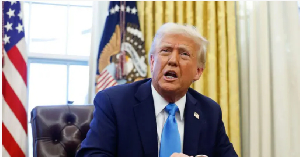Even though economic analysts and econometric modeling teams have been busy revising their growth forecasts for the Ghanaian economy downwards, due to the expected effects of the ongoing second wave of COVID 19, the country’s financial markets are reacting in a contrary fashion to what conventional economic doctrine would suggest.
The stock market is rising, interest rates are falling and the cedi is not depreciating against the United States dollar despite a fall in export revenues triggered by both slackened global demand and disruptions to international supply chains.
To be sure though, there are reasons why these trends are happening that are peculiar to Ghana. The cedi exchange rate is being kept stable by the fact that lower imports are being nearly matched by an almost commensurate fall in imports, and a narrowing of the current account deficit; along with the build- up of record high gross international reserves and improved price discovery through the Bank of Ghana’s regular forward foreign exchange auctions, both of which have engendered confidence that forex will be available in sufficient quantities and at close to current spot rates.
Interest rates are falling because of deliberate monetary policy by the central bank and government’s use of its dominant demand volumes for credit to influence the rates. The stock market is rising because exchange rates have stabilized, interest rates are falling and underpinning all this, three successive years of falling equity prices have left most of them underpriced. Most important for both enterprises and households in Ghana is the trend on the forex market as this is – along with local produced food prices – the biggest determinant of inflation.
Thus the stability of the cedi since the beginning of 2021 counts as a huge plus, more so since added to the relative stability it enjoyed all through 2020, it suggests that the continuous depreciation of the cedi since it was first floated in 1985 – in defiance of economic doctrine as set out by the concept of the J curve – is now over as negative speculation has been curbed by forward forex sales leaving exchange rates to be determined by macroeconomic fundamentals, just as they should be.
The latest fortnightly forex auction conducted last week has followed what seems to be a sustained pattern. Forward bids for delivery of US dollars over various tenors between seven and 75 days are only marginally higher than the ruling spot price, the difference in fact based on the bidders need to secure purchases with demand higher than the amount put up for sale, rather than any actual expectations of significant cedi depreciation.
Instructively, the correlation between forward delivery tenor and bid rate is inverse with longer tenors attracting lower bids than shorter tenors. This in part because longer-tenured bids – and volume demanded – are less than shorter tenured bids and so there is less pressure on bidders to ensure that their bids are price competitive enough to succeed.
But this also suggests that bidders suspect the cedi could appreciate in the near future, especially with a record large-sized Eurobond issuance scheduled for just a few weeks from now.
The latest forward foreign exchange auction conducted by the Bank of Ghana last week indicates continued exchange rate stability at least until the end of April. Even the single bid for delivery of US dollars 75 days from the auction date – February 9 – was for GH¢5.7850 to the dollar, which is only marginally higher than the spot market price.
Altogether US$50 million was put up for sale with demand reaching US$98.15 million, this translating to a bid cover ratio of 1.96 times. As usual demand was concentrated at the short end of the spectrum.
There were 47 bids for delivery in seven days time of which 19 were accepted at prices of between GH¢5.8010 and GH¢5.8100. Cumulative demand was US$56.9 million of which US$22.75 million was sold.
There were 32 bids for delivery in 15 days, with demand reaching US$22.5 million of which US$11 million was actually sold at bid rates of between GH¢5.8041 and GH¢5.8175.
For 30 days delivery there were 14 bids amounting to US$9.5 million of which US$7.75 million was accepted at rates ranging between GH¢5.8015 and GH¢5.8462.
Demand for delivery in 45 days was US$5.78 million of which US$5.00 million was sold at rates ranging from GH¢5.7900 and GH¢5.8300. Of the 10 bids made nine were accepted.
There were six bids for a cumulative US$ 3 million for delivery in 60 days and all the bids were accepted at rates ranging between GH¢5.75705 and GH¢5.7980.
Instructively there were no bids of up to GH¢5.90 for delivery at any tenor. This evidences the confidence forex users and their market traders have that the cedi’s exchange rate will remain stable going forward.
Gross International Reserves remain at well over US$8 billion and if Ghana’s planned imminent Eurobond issuance of up to US$5 billion successful there is the possibility that those reserves could reach the all time high of US$9.9 billion reached two years ago.
This creates the real possibility of marginal appreciation of the cedi, a possibility recognized by bidders at the ongoing forward sales who are bidding higher rates for the shortest delivery tenors than they are for the longest tenors of 60 and 75 days; this based on the expectation that by that time the next Eurobond issuance will have been completed with a positive effect on the exchange rate.
The reaction of the money market, as measured by rates on the Ghana Fixed Income Market, to COVID 19 has been reassuring too. Although monetary easing was always going to put downward pressure on interest rates to stimulate economic growth and head off a recession, government’s sharply increased need for dramatically increased fiscal deficit financing has posed a clear and present danger to Ghana’s short term credit driven private sector.
But prudent monetary policy by the Bank of Ghana, accompanied by sensible fiscal deficit financing strategy by the Ministry of Finance, has kept a tight lid on lending rates.
Even though the Bank of Ghana announced at the end of January that it is maintaining its benchmark Monetary Policy Rate at 14.5 percent for the next two months – which means that this rate would have been retained for 12 calendar months by the next time it is reviewed – borrowers are benefitting from the fact that interest rates continue to fall in Ghana despite government’s unprecedented demand for fiscal deficit financing.
Ultimately monetary easing by the central bank has negated the upward pressure on interest rates created by higher demand for credit by government although inevitably commercial banks have been moving from loans to the private sector, towards lending to government.
Lower interest rates at a time that government’s unprecedentedly high demand for credit is supposed to raise them – going by the basic economic principle of demand and supply – is a veritable achievement, effectively turning basic economic doctrine, proven over the past nearly two hundred years on its head. It has been achieved by the combination of several initiatives thought out outside of the box.
The biggest single one was the Bank of Ghana’s extending GHc10 billion in fiscal deficit financing to government, which gave the state access to this money without affecting the quantum available to private sector borrowers.
Ironically, this was controversial at the time the BoG offered government the money, because the central bank had committed to the International Monetary Fund in 2016 not to fund the fiscal deficit at all.
But because of the peculiar circumstances the BoG provided this financing without triggering any significant macroeconomic instability because the economy was operating below full capacity.
The result was that the money market was left with enough money to cater for private sector borrowers because government’s extra demand for fiscal deficit financing had been largely catered for by the central bank.
Another initiative was the monetary stimulus provided by the BoG in several ways. The minimum capital and reserve requirements were lowered, monetary incentives were offered for banks to engage in repo transactions and regulatory sanctions on non-performing loan assets on bank balance sheets were temporarily reduced.
Furthermore government itself negotiated a 200 basis points cut on new loans booked by banks during the COVID-19 crisis. This came on the back of a reduction in the Ghana Reference Rate, which is computed by the banks in close consultation with the BoG itself and which effectively serves as the base lending rate for the entire industry with each bank adding on a margin for each loan it gives, serving as the risk premium for each particular loan.
All these pushed short-term interest rates downwards despite government’s bigger appetite for debt. This is key since private sector borrowers take primarily short term credit since that is what banks primarily offer, due to the dearth of long term deposits to fund long term loans.
However, the BoG deliberately allowed longer term interest rates to rise to retain the interest of foreign investors who are the major subscribers to government debt securities issued over long tenors.
Now however, with the cedi exchange rate proving more or less stable – thereby removing the risk to foreign portfolio investors of exchange rate losses – and inflation now returned to single digits, (9.9 percent in January) those medium to long term rates are now being allowed to fall too.
This means medium and long term borrowers from banks and issuers of corporate bonds on both the Ghana Stock Exchange itself and the Ghana Alternative stock market can start benefitting from monetary easing, just as the majority of business borrowers, who borrow at the short end of the spectrum have been doing since the second quarter of last year.
Interest rates on the money market broadly showed downward trends across the yield curve through most of last year in response to deliberate monetary policy.
The 91-day declined to 14.1percent in December 2020 from 14.7 percent a year earlier, and the 182-day Treasury bill rate fell to 14.1 percent from 15.2 percent over the same comparative period.
Similarly, two year notes declined from 20;95 percent by the end of 2019 to 20.20 percent by the end of last year. The rates on three and five year bonds were actually increasing immediately prior to the commencement of monetary easing peaking at 20.75 percent and 21.7- percent respectively by March before the sharp cut in the Monetary Policy Rate by 150 basis points (from 16 percent to the current 14.50 percent) subsequently pushed them down to 19.25 percent and 19.85 percent respectively as at the end of last year.
This has been the result of deliberate policy since most credit in Ghana is provided over short tenors and therefore the effective cost of borrowing for most enterprises and households continues to decline.
But the most recent trend reversals have been at the longer end of the money market. Until a few months ago rates on long tenured securities were allowed to rise to retain the interest of foreign portfolio investors who demand a wide premium on their cedi-denominated investments to protect them against possible – and until very recently, likely – foreign exchange losses caused by cedi depreciation.
Since the last quarter of 2020 however, with the cedi having proved more or less stable and foreign investors faced with uncompetitive, near zero coupon rates in their home countries, the rates on these longer term rates have been falling too.
On the secondary bond market, yields on 6-year, 7-year, 10-year, and 15-year bonds had all declined by the end of 2020 from the peaks reached in October. Six year bond yields were down to 19.76 percent, from 19.96 percent.
Seven-year bond yields were down to 19.74 percent from 20.09 percent; 10 year bonds were down to 21.00 percent from 21.22 percent; 15 year bonds down to 21.23 percent from 21.83 percent; and 20 year bond yields had fallen to 22.28 percent from 22.40 percent.
Falling long term bond rates should encourage the corporations that have approval to issue bonds to the tune of a cumulative GHc4.4 billion, from stock market managers and regulators, but who have suspended their phased issuance over the past year because of rising coupon rates.
The weighted average interbank rate declined to 13.6 percent from 15.2 percent, last year reflecting the reduction in the monetary policy rate in March 2020, and improved liquidity conditions on the market.
Similarly, average lending rates of banks declined to 21.1 percent in December 2020 from 23.6 percent recorded in the corresponding period of 2019, consistent with the monetary policy stance.
Going forward, even though the MPR has not been reduced yet, long term interest rates are likely to fall further to flatten the inordinately steep yield curve – which has resulted from falling short term rates and rising long term rates for the past nine months – even if short term rates do not fall any further. When the MPR is eventually lowered further – still a distinct possibility sometime later this year, then short term rates will fall further too.
But arguably the most pleasant surprise has come in the capital market. Finally, after the longest running bear market in its 30 year history the equities segment of the Ghana Stock Exchange is showing early signs of a return to a bull market in 2021 despite the macroeconomic uncertainties in which it operates, and an inevitable, COVID-19 instigated slump in revenues for corporate Ghana in general
But the Ghana Stock Exchange is benefitting from a more stable cedi – which is attracting attract foreign investors in particular – and falling interest rates on the Ghana Fixed Income Market. Ecobank Development Corporation expects local bank and oil-company shares in particular to be in demand, driving bullish sentiment.
Indeed, equity market analysts are predicting a surge in share prices this year. The benchmark Ghana Stock Exchange Composite Index of 31 shares is set to gain as much as 15% this year, Nene Lomo Nartey, head of trading and sales at Ecobank Development Corporation has told Bloomberg, predicting that demand for local banks and oil company shares will lead the price rebound.
During the first five weeks of 2021 – from the start of trading this year to February 5 – the GSE Composite Index rose by 5.84 percent, propelled largely by a 4.57 percent rise in the Financial Index.
Although equity analysts do not expect this momentum to be maintained throughout the year, they point out that this strong early performance suggests that finally, equity investors can expect capital gains this year rather than the capital losses they have suffered since 2018.
Following an exemplary 52.73 percent rise in the composite index in 2017 – driven by the liquidity injection brought about by governments release of several years accumulated private pensions funds contributions to their fund managers – the index has since fallen every year; by a mild 0.2 percent in 2018 but a much sharper 19.25 percent in 2019 and about 12 percent last year.
In each case the financial index had a huge impact, falling by 6.79 percent in 2018 and 6.23 percent in 2019 as profound financial sector regulatory reforms sought to bring back financial intermediation and fund management firms from a looming abyss.
The resilience of financial intermediation companies to the adverse effects of COVID 19 has evidenced their new solidity and equity investors are enthused.
Another important factor is the cedi’s exchange rate stability. Foreign investors, whom have traditionally been major players in the equity market, can now look at returns on investment without having to worry about those cedi-denominated returns being lost to cedi depreciation.
“Foreign demand began returning in the last quarter and we think that will be sustained by the government’s commitment to get COVID-19 vaccines, which raises the prospects for economic recovery,” Nartey says. The cedi’s depreciation against the dollar in 2020 was the slowest in 14 years and government and central bank efforts to extend this positive momentum are likely to continue, he said. EDC expects the economy to expand by 4.5% this year, compared with a government forecast of 5.7%.
Besides all this many stocks are trading at long term low price-earnings ratios, with some trading below their respective book ratios.
Local lenders are in a healthy state following a sweeping cleanup of the sector that started in 2017 that saw scores of lenders and micro-credit companies shut down. Nartey expects GCB Bank Ltd., Standard Chartered Bank Ghana Plc, Ecobank Ghana Plc and Enterprise Group Plc to post gains this year because investors are beginning to see value in these stocks.
“There’s a lot of demand for GCB, but not many sell offers, because people are optimistic about the financial sector,” he said. “When you’re looking for Ecobank Ghana and Stanchart, you don’t get all the volumes you want to purchase.” EDC is the investment arm of Ecobank Transnational Inc., the parent of Ecobank Ghana.
Oil marketing companies have returned to pre-pandemic levels of operation, and Ghana Oil Co. and Total Petroleum Ghana Plc are trading at attractive entry points, he said.
Here are some of Nartey’s views on other stocks:
Fan Milk Ltd.’s results were impressive and it is trading close to an historical lowScancom Plc, the local unit of MTN Group, Africa’s biggest wireless carrier, is a strong buy because the pandemic increased demand for its servicesUnilever Ghana Plc may be among the laggards, because it’s struggling to grow core revenueGuinness Ghana Breweries Plc may underperform because of its debt profile “We’re getting out of the trough,” Nartey says.
“Across the board with a lot of the stocks you see that demand is exceeding supply and the least that comes with that is going to be people willing to pay a little premium.”
The stockmarket’s rebound completes a tripod of financial market resilience which will be crucial in enabling Ghana to navigate what promises to be a most difficult year for the economy as COVID 19’s second wave and the requisite socio-economic restrictions being re-imposed to curtail is spread take their toll.
Business News of Monday, 15 February 2021
Source: goldstreetbusiness.com













